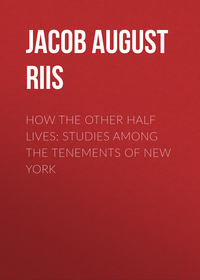 полная версия
полная версияThe Battle with the Slum
Half the tenement house population—and I am not sure that I ought not to say the whole of it—is everlastingly on the move. Dr. Gould quotes as an instance of it the experience of an assembly district leader in distributing political circulars among the people in a good tenement neighborhood. In three months after the enrolment lists had been made out, one-third of the tenants had moved. No doubt the experience was typical. How can the one who hardly knows what a home means be expected to have any pride or interest in his home in the larger sense: the city? And to what in such men is one to appeal in the interests of civic betterment? That is why every effort that goes to help tie the citizen to one spot long enough to give him the proprietary sense in it which is the first step toward civic interest and pride, is of such account. It is one way in which the public schools as neighborhood houses in the best sense could be of great help, and a chief factor in the success of the social settlement. And that is why model tenements, which pay and foster the home, give back more than a money interest to the community.
They must pay, for else, as I said, they will not stay. These pay four per cent, and are expected to pay five, the company's limit. So it is not strange that the concern has prospered. It has since raised more than one million of dollars, and has built another block, with room for 338 families, on First Avenue and on Sixty-fourth and Sixty-fifth streets, within hail of Battle Row, of anciently warlike memory. Still another block is going up at Avenue A and Seventy-eighth Street, and in West Sixty-second Street, where the colored population crowds, the company is erecting two buildings for negro tenants, where they will live as well as their white fellows do in their model tenements,—a long-delayed act of justice, for as far back as any one can remember the colored man has been paying more and getting less for his money in New York than whites of the same grade, who are poorer tenants every way. The Company's "city homes" come as near being that as any can. There is light and air in abundance, steam heat in winter in the latest ones, fireproof stairs, and deadened partitions to help on the privacy that is at once the most needed and hardest to get in a tenement. The houses do not look like barracks. Any one who has ever seen a row of factory tenements that were just houses, not homes, will understand how much that means. I can think of some such rows now, with their ugly brick fronts, straight up and down without a break and without a vine or a window-box of greens or flowers, and the mere thought of them gives me the blues for the rest of the day. There is nothing of that about these tenements, unless it be the long play-yard between the buildings in Sixty-eighth and Sixty-ninth streets. It is too narrow to have anything in it but asphalt. But the rest makes up for it in part.
All together, the company has redeemed its promise of real model tenements; and it has had no trouble with its tenants. The few and simple rules are readily understood as being for the general good, and so obeyed. It is the old story, told years and years ago by Mr. Alfred T. White when he had built his Riverside tenements in Brooklyn. The tenants "do not have to come up" to the landlord's standard. They are more than abreast of him in his utmost endeavor, if he will only use common sense in the management of his property. They do that in the City and Suburban Homes Company's buildings. They give their tenants shower-baths and a friend for a rent-collector, their children playrooms and Christmas parties, and the whole neighborhood feels the stimulus of the new and humane plan. In all Battle Row there has not been a scrap, let alone an old-time shindy, since the "accommodation flats" came upon the scene. That is what they call them. It is an everyday observation that the Row has "come up" since some of the old houses have been remodelled. The new that are being built aim visibly toward the higher standard.
The company's rents average a dollar a week per room, and are a trifle higher than those of the old tenements round about; but they have so much more in the way of comfort that the money is eagerly paid; nor is the difference so great that the "picking of tenants" amounts to more than the putting of a premium on steadiness, sobriety, and cleanliness, which in itself is a service to render. One experience of the management which caused some astonishment, but upon reflection was accepted as an encouraging sign, was the refusal of the tenants to use the common wash-tubs in the laundry. They are little used to this day. The women will use the drying racks, but they object to rubbing elbows with their neighbors while they wash their clothes. It is, after all, a sign that the tenement that smothers individuality left them this useful handle, and if the experience squashed the hopes of some who dreamed of municipal wash-houses on the Glasgow plan, there is nothing to grieve over. Every peg of personal pride rescued from the tenement is worth a thousand theories for hanging the hope of improvement on.
With $2,300,000 invested by this time, the company has built city homes for 1450 families, and has only made a beginning. All the money that is needed for going on with its work is in sight. Nor are the rich the only investors. Of the 400 stockholders 250 have small lots, ten shares and less each, a healthy sign that the company is holding the confidence of the community. It has fairly earned it. No one could have done a greater and better thing for the metropolis than to demonstrate that it is possible to build homes for the toilers as a business and net a business interest upon the investment.
The statement is emphasized by the company's experience with the suburban end of its work. It bought sites for two or three hundred little cottages out on Long Island, but within the greater city, and only half an hour by trolley or elevated from the City Hall. A hundred houses were built, neat and cosey homes of brick and timber, each in its own garden; and a plan was devised under which the purchaser had twenty years to pay for the property. A life insurance policy protected the seller and secured the house to the widow should the breadwinner die. The plan has worked well in Belgium under the eyes of the government, but it failed to attract buyers here. Of those whom it did attract at the outset, not a few have given up and gone away. When I went out to have a look at the place the year after Homewood had been settled, seventy-two houses had found owners under the company's plans. After four years fifty-six only are so held, ten have been bought outright, and three sold under contract. Practically the company has had to give up its well-thought-out plan and rent as many of the houses as it could. Nine were vacant this last spring.
So what we all thought the "way out" of the slum seems barred for the time being. For there is no other explanation of the failure than that the people will not go "among the stumps." Lack of facilities for getting there played a part, possibly, but a minor one, and now there is no such grievance. The simple fact is that the home-feeling that makes a man rear a home upon the soil as the chief ambition of his life was not there. The tenement and the flat have weakened that peg among the class of workers for whom Homewood was planned. I hate to say that they have broken the peg, for I do not believe it. But it has been hurt without doubt. They longed for the crowds. The grass and the trees and the birds and the salt breath of the sea did not speak to them in a language they understood. The brass bands and the hand-organs, the street cries and the rush and roar of the city, had made them forget their childhood's tongue. For the children understood, even in the gutter.
"It means, I suppose," said Dr. Gould to me, when we had talked it all over, "that we are and always shall be a tenement house city, and that we have got to reckon with and plan for that only."
I think not. I believe he is mistaken. And yet I can give no other ground for my belief than my unyielding faith that things will come right yet, if it does take time. They are not right as they are. Man is not made to be born and to live all his life in a box, packed away with his fellows like so many herring in a barrel. He is here in this world for something that is not attained in that way; but is, if not attained, at least perceived when the daisies and the robins come in. If to help men perceive it is all we can do in our generation, that is a good deal. But I believe that before our children have come to the divide, perhaps before we are gone, we shall see the tide of the last century's drift to the cities turn, under the impulse of the new forces that are being harnessed for man's work, and Homewood come to its rights, I say I believe it I wish I could say I knew; but then you would ask for my proofs, and I haven't any. For all that, I still believe it.
Meanwhile Dr. Gould's advice is good sense. If he is right, it is of the last importance; if I am right, it is still the way to proving me so by holding on to what is left of the home in the tenement and making the most of it. That we have taken the advice is good ground for hope, in the face of the fact that New York has still the worst housing in the world. We can now destroy what is not fit to stand. We have done it, and the republic yet survives. The slum landlord would have had us believe that it must perish with his rookeries. We are building model tenements and making them pay. Alfred T. White's Riverside tenements are as good to-day as when they were built a dozen years ago—better if anything, for they were honestly built—and in all that time they have paid five and six per cent, and even more. Dr. Gould found that only six per cent of all the great model housing operations which he examined for the government here and abroad had failed to pay. All the rest were successful. And by virtue of the showing we have taken the twenty-five-foot lot itself by the throat.
Three years ago, speaking of it as the one thing that was in the way of progress in New York, I wrote: "It will continue to be in the way. A man who has one lot will build on it; it is his right. The state, which taxes his lot, has no right to confiscate it by forbidding him to make it yield him an income, on the plea that he might build something which would be a nuisance. But it can so order the building that it shall not be a nuisance; that is not only its right, but its duty."

The Riverside Tenements in Brooklyn.
That duty has been done since; let me tell how. Popular sentiment, taking more and more firmly hold of the fact that there is a direct connection between helpless poverty and bad housing, shaped itself in 1898 into a volunteer Tenement House Committee which, as an effective branch of the Charity Organization Society, drew up and presented to the municipal authorities a reform code of building ordinances affecting the dwellings of the poor. But Tammany was back, and they would not listen at the City Hall. Seeing which, the committee made up its mind to appeal to the people themselves in such fashion that it should be heard. That was the way the Tenement House Exhibition of the winter of 1900 came into existence.
Rich and poor came to see that speaking record of a city's sorry plight, and at last we all understood. Not to understand after one look at the poverty and disease maps that hung on the wall was to declare oneself a dullard. The tenements were all down in them, with the size of them and the air space within, if there was any. Black dots upon the poverty maps showed that for each one five families in that house had applied for charity within a given time. There were those that had as many as fifteen of the ominous marks, showing that seventy-five families had asked aid from the one house. To find a tenement free from the taint one had to search long and with care. Upon the disease maps the scourge of tuberculosis lay like a black pall over the double-decker districts. A year later the State Commission, that continued the work then begun, said: "There is hardly a tenement house in which there has not been at least one case of pulmonary tuberculosis within the last five years, and in some houses there have been as many as twenty-two different cases of this terrible disease. There are over 8000 deaths a year in New York City from this disease alone, at least 20,000 cases of well-developed and recognized tuberculosis, and in addition a large number of obscure and incipient cases. The connection between tuberculosis and the character of the tenement houses in which the poor people live is of the very closest."23

A Typical East Side Block.
A model was shown of a typical East Side block, containing 2781 persons on two acres of land, nearly every bit of which was covered with buildings. There were 466 babies in the block (under five years), but not a bath-tub except one that hung in an air shaft. Of the 1588 rooms 441 were dark, with no ventilation to the outer air except through other rooms; 635 rooms gave upon twilight "air shafts." In five year 32 cases of tuberculosis had been reported from that block, and in that time 660 different families in the block had applied for charity. The year before the Bureau of Contagious Diseases had registered 13 cases of diphtheria there. However, the rent-roll was all right. It amounted to $113,964 a year.

Robert W. de Forest, Chairman of the Tenement House Commission of 1900.
Those facts told. New York—the whole country—woke up. More than 170 architects sent in plans in the competition for a humane tenement that should be commercially profitable. Roosevelt was governor, and promptly appointed a Tenement House Commission, the third citizen body appointed for such purposes by authority of the state. Mr. Robert de Forest, a distinguished lawyer and a public-spirited man, who had been at the head of the Charity Organization Society and of the relief efforts I spoke of, in time became its chairman, and commissioner of the new Tenement House Department that was created by the new charter of the city to carry into effect the law the commission drew up. At this writing, with the department not yet fully organized, it is too early to say with any degree of certainty exactly how far the last two years have set us ahead; but this much is certain:
"Discretion" is dead—at last. In Manhattan, no superintendent of buildings shall have leave after this to pen tenants in a building with stairs of wood because he thinks with luck it might burn slowly; nor in Brooklyn shall a deputy commissioner rate a room with a window opening on a hall, or a skylight covered over at the top, "the outer air."24 Of these things there is an end. The air shaft that was a narrow slit between towering walls has become a "court," a yard big enough for children to run in. Thirty per cent of the tenement-house lot must be open to the sun. The double-decker has had its day, and it is over. A man may still build a tenement on a twenty-five-foot lot if he so chooses, but he can hardly pack four families on each floor of it and keep within the law. He can do much better, and make an ample profit, by crossing the lot line and building on forty or fifty feet; in consequence of which, building being a business, he does so. In a lot of half a hundred tenement plans I looked over at the department yesterday, there were only two for single houses, and they had but three families on the floor.
So it seems as if the blight of the twenty-five-foot lot were really wiped out with the double-decker. And no one is hurt. The speculative builder weeps—for the poor, he says. He will build no more, he avers, and rents will go up, so they will have to sleep on the streets. But I notice the plans I spoke of call for an investment of three millions of dollars, and that they are working overtime at the department to pass on them, so great is the rush. Belike, then, they are crocodile tears. Anyway, let him weep. He has laughed long enough.

1. Old Knickerbocker dwelling.
2. The same made over into a tenement.
3. The rear tenement caves.
4. Packing-box tenement built for revenue only.
5. The limit; the air shaft—first concession to tenant.
6. The double-decker, where the civic conscience began to stir in 1879.
7. Evolution of double-decker up to date.
8. Prize plan of Tenement House Exhibition, 1900 (fifty-foot lot).

Plan of a Typical Floor in Class First of the Competition in the C. O. S. Plans of Model Tenements.
Rentable area 2724.94o = 54.70% of lot
Free air-space (courts) 1500.25o = 30.01% of lot
Walls, partitions, and public space 764.81o = 15.29% of lot
Total 5000.00o = 100.00% = lot
3 two-room apartments
3 three-room apartments
2 four-room apartments
8 apartments. 23 rooms
As for the rents, he will put them as high as he can, no doubt. They were too high always, for what they bought. In the case of the builder the state can add force to persuasion, and so urge him along the path of righteousness. When it comes to the rent collector the case is different. It may yet be necessary for the municipality to enter the field as a competing landlord on the five-per-cent basis; but I would rather we, as a community, learned first a little more of the art of governing ourselves without scandal. With Tammany liable to turn up at any moment—no, no! Political tenements might yet add a chapter to the story of our disgrace to make men weep. I have not forgotten the use Tammany made of the people's baths erected in the Hamilton Fish Park on the East Side—the Ham-fish, locally. They were shut from the day they were opened, I came near saying; I mean from the day they should have been opened; and two stalwart watchmen drew salaries for sitting in the door to keep the people out. That was a perfectly characteristic use of the people's money, and is not lightly to be invited back. Rather wait awhile yet, and see what our bridges and real rapid transit, and the "philanthropy and five per cent" plan, will do for us. When that latter has been grasped so by the tenant that a little extra brass and plate-glass does not tempt him over into the enemy's camp, the usurious rents may yet follow the double-decker, as they have clung to it in the past.
But if the city may not be the landlord of tenements, I have often thought it might with advantage manage them to the extent of building them to contain so many tenements on basis of air space, and no more. The thing was proposed when the tenement house question first came up for discussion, but was dropped then. The last Tenement House Commission considered it carefully, but decided to wait and see first how the new department worked. The whole expense of that, with its nearly two hundred inspectors, might easily be borne by the collection of a license fee so small that even the tenement house landlord could not complain. Lodging houses are licensed, and workshops in the tenements likewise, to secure efficient control of them. If that is not secured in the case of the workshops, as it is not, it is no fault of the plan, but of the working out of it. I do not expect the licensing of tenements to dispose of all the evils in them. No law or system will ever do that. But it ought to make it easier to get the grip on them that has been wanting heretofore, to our hurt.
CHAPTER VI
THE MILLS HOUSES
Sitting by my window the other day, I saw a boy steering across the street for my little lad, who was laying out a base-ball diamond on the lawn. It seems that he knew him from school.
"Hey," he said, as he rounded to at the gate, "we've got yer dad's book to home; yer father was a bum onct."

A Seven-cent Lodging House in the Bowery.
Proof was immediately forthcoming that whatever the father might have been, his son was able to uphold the family pride, and I had my revenge. Some day soon now my boy will read his father's story25 himself, and I hope will not be ashamed. They read it in their way in the other boy's house, and got out of it that I was a "bum" because once I was on the level of the Bowery lodging house. But if he does not stay there, a man need not be that; and for that matter, there are plenty who do whom it would be a gross injury to call by such a name. There are lonely men, who, with no kin of their own, prefer even such society as the cheap lodging house has to offer to the desolation of the tenement; and there are plenty of young lads from the country, who, waiting in the big city for the something that is sure to turn up and open their road to fortune, get stranded there. Beginning, perhaps, at the thirty-cent house, they go down, down, till they strike the fifteen or the ten cent house, with the dirty sheets and the ready club in the watchman's hand. And then some day, when the last penny is gone, and the question where the next meal is going to come from looms larger than the Philippine policy of the nation, a heavy-browed man taps one on the shoulder with an offer of an easy job—easy and straight enough in the mood the fellow is in just then; for does not the world owe him a living? It is one of the devil's most tempting baits to a starving man that makes him feel quite a moral hero in taking that of which his more successful neighbor has deprived him. The heavy-browed fellow is a thief, who is out recruiting his band which the police have broken up in this or some other city. By and by his victim will have time, behind prison bars, to make out the lie that caught him. The world owes no man a living except as the price of honest work. But, wrathful and hungry, he walks easily into the trap.

They had a Mind to see how it looked.
That was what Inspector Byrnes meant by calling the cheap lodging houses nurseries of crime. I have personally, as a police reporter, helped trace many foul crimes to these houses where they were hatched. They were all robberies to begin with, but three of them ended in murder. Most of my readers will remember at least one of them, the Lyman S. Weeks murder in Brooklyn, a thoroughly characteristic case of the kind I have described. A case they never heard of, because it was nipped in the bud, was typical of another kind. Two young Western fellows had come on, on purpose to hold up New York, and were practising in their lodging, but not, it seems, with much success, for the police pulled them in at their second or third job. When searched, a tintype, evidently of Bowery make, was found in the pocket of one, showing them at rehearsal. They grinned when asked about it. "We done a fellow up easy that way," they said, "and we'd a mind to see how it looked." They were lucky in being caught so soon. A little while, and the gallows would have claimed them, on the road they were travelling.
I mention this to show the kind of problem we have in our Bowery lodging houses, with their army of fifteen or sixteen thousand lodgers, hanging on to the ragged edge most of them, and I have only skimmed the surface of it at that. The political boss searches the depths of it about election time when he needs votes; the sanitary policeman in times of epidemic, when smallpox or typhus fever threatens. All other efforts to reach it had proved unavailing when D. O. Mills, the banker, built his two "Mills Houses," No. 1 in Bleecker Street for the West Side and No. 2 in Rivington Street for the homeless of the East Side. They did reach it, by a cut 'cross lots as it were, by putting the whole thing on a neighborly basis. It had been just business before, and, like the keeping of slum tenements, a mighty well-paying one. The men who ran it might well have given more, but they didn't. It was the same thing over again: let the lodgers shift as they could; their landlord lived in style on the avenue. What were they to him except the means of keeping it up?











